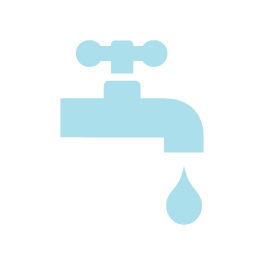 Water Infrastructure Investment
Water Infrastructure Investment
Resource Needs
As with most infrastructure in the region the overarching needs include time, incentives and improved funder support.
Time
To arrive at system cost improvements required to meet a growth opportunity, the location, type, size and demand of the new development must be known. The Water Systems Analysis provided here allow comparison of capacity between systems and indicates areas of strength and weakness.
The ideal is to have Geographic Information System (GIS) mapping, an asset management plan (AMP) and/or primacy needs assessments for all utilities in the region. An AMP along with a preventative maintenance budget takes about 18-24 months to develop. Only the superintendent/operators know the equipment details to complete the required conditioning attributes of the AMP. This timeframe is impacted by the daily operation and maintenance tasks along with schedule construction during the spring, summer and fall. Also, approval from the board/council is required for the superintendent to commit work hours.
Although the superintendents may complete and present an AMP to their board/council, the incentives for the “purse-string holders” are reluctant to raise rates to accommodate such medium- to long-term planning.
Incentives
A regulatory requirement for utilities to have an up-to-date complete critical equipment repair/replacement cost schedule (or AMP) would support utility motivation. Additional incentives to having an AMP may include:
- increase funding to have technical assistance for AMP creation,
- an increase in grant component and/or
- decrease in loan interest and/or
- increase in loan term.
Money
All funding agencies (listed below) should collectively improve and support creation and use of asset management plans for funding qualification. All funding applications for system improvements should include and be supported by asset management plan priority lists.
Community Development Block Grant (CDBG) – Public Infrastructure Grant Program
The Public Infrastructure Grant Program (PI) provides funds for communities to address local issues, which are part of a community development strategy leading to future public and private investments. The Eligible activities include construction, acquisition, reconstruction, installation, rehabilitation, site clearance, historic preservation, and relocation assistance associated with public projects and infrastructure in support of new affordable housing construction. Program activities are grouped as follows: Water system installation/improvements, Sewer system installation/improvements, Water/sewer system hookups, and Storm drainage, and Other Utility infrastructure –Maximum grant award: $1,000,000. For more information, www.meocd.org
USDA Rural Development – Water and Waste Disposal Direct Loans and Grants
The Water and Waste Disposal Direct Loans and Grants Program provides funding to towns with a population not in excess of 10,000 for the purpose of developing water and waste disposal systems. The funds are available to public bodies, non-profit corporations and Indian tribes.
Funds can be used for construction, land acquisition, legal fees, engineering fees, capitalized interest, equipment, initial operation and maintenance costs, project contingencies, and any other cost that is determined by the Rural Development to be necessary for the completion fo the project. For more information, www.rurdev.usda.gov/RD_Grants
Maine Drinking Water Program
The Maine Drinking Water Program offers a variety of low interest loans to community or non-profit organizations, non-community public water systems for infrastructure improvements.
- Very Small System Compliance Loan Fund provides 100% principal forgiveness loans for water treatment improvements required to achieve compliance with Safe Drinking Water Act standards.
- Capacity Development Grants of up to 50% of the project costs up to a maximum reimbursement of $10,000 is available for community and non-profit, non-community public water systems to help with the preparation of documents that will assist them in the maintenance or enhancement of water quality by identifying possible improvements in systems, technical, financial and managerial operations.
- System Consolidation Grants are available for systems with a technical, managerial, or financial capacity issue that will be addressed by the consolidation with a more viable public water system. Grants may not exceed $100,000.
- Source Water Protection Grant Program provides $5,000 in grant funds to public water systems with surface water sources. Projects must clearly reduce the likelihood of contamination occurring in the source water protection area by existing and future activities.
- Wellhead Protection Grant Program provides up to $5,000 in grant funds for projects that clearly reduce the likelihood of contamination occurring in the wellhead protection area by existing and future activities. For more information on the Drinking Water Programs, www.maine.gov/dhhs/mecdc/environmental-health/water
For Assistance with these funding programs in Washington County contact Judy East 454-0465
Results for individual water systems in Aroostook County and for Washington County are provided here.
Training and Technical Assistance
Water Systems Assistance - Happening Now, and
Water Systems Assistance - Going Forward

Share this content: